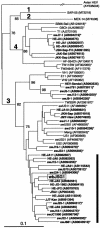Prevalence of hepatitis E virus (HEV) Infection in wild boars and deer and genetic identification of a genotype 3 HEV from a boar in Japan
- PMID: 15528746
- PMCID: PMC525261
- DOI: 10.1128/JCM.42.11.5371-5374.2004
Prevalence of hepatitis E virus (HEV) Infection in wild boars and deer and genetic identification of a genotype 3 HEV from a boar in Japan
Abstract
Zoonotic transmission of hepatitis E virus (HEV) from captured wild deer or boars to humans has been suggested. Antibody to HEV was detected in 9% of 35 wild boars and 2% of 117 wild deer tested, and a presumably indigenous HEV of genotype 3 was isolated from a boar in Japan.
Figures


Similar articles
-
[Molecular Investigation on the Presence of Hepatitis E Virus in Wild Game in Okazaki City, Japan between April 2010 and November 2014].Shokuhin Eiseigaku Zasshi. 2015;56(6):252-5. doi: 10.3358/shokueishi.56.252. Shokuhin Eiseigaku Zasshi. 2015. PMID: 26699273 Japanese.
-
Recent Hepatitis E Virus Infection in Wild Boars and Other Ungulates in Japan.Viruses. 2025 Apr 4;17(4):524. doi: 10.3390/v17040524. Viruses. 2025. PMID: 40284967 Free PMC article.
-
Characterization and zoonotic potential of endemic hepatitis E virus (HEV) strains in humans and animals in Hungary.J Clin Virol. 2009 Apr;44(4):277-81. doi: 10.1016/j.jcv.2009.01.008. Epub 2009 Feb 12. J Clin Virol. 2009. PMID: 19217346
-
The molecular epidemiology of hepatitis E virus infection.Virus Res. 2011 Oct;161(1):31-9. doi: 10.1016/j.virusres.2011.04.030. Epub 2011 May 11. Virus Res. 2011. PMID: 21600939 Review.
-
[Hepatitis E as a zoonosis].Nihon Rinsho. 2004 Aug;62 Suppl 8:524-31. Nihon Rinsho. 2004. PMID: 15453377 Review. Japanese. No abstract available.
Cited by
-
Transmission dynamics of hepatitis E among swine: potential impact upon human infection.BMC Vet Res. 2007 May 10;3:9. doi: 10.1186/1746-6148-3-9. BMC Vet Res. 2007. PMID: 17493260 Free PMC article.
-
Hepatitis E virus: animal reservoirs and zoonotic risk.Vet Microbiol. 2010 Jan 27;140(3-4):256-65. doi: 10.1016/j.vetmic.2009.03.017. Epub 2009 Mar 20. Vet Microbiol. 2010. PMID: 19361937 Free PMC article. Review.
-
Zoonotic hepatitis E: animal reservoirs and emerging risks.Vet Res. 2010 Nov-Dec;41(6):46. doi: 10.1051/vetres/2010018. Epub 2010 Apr 2. Vet Res. 2010. PMID: 20359452 Free PMC article. Review.
-
Evolutionary history and population dynamics of hepatitis E virus.PLoS One. 2010 Dec 17;5(12):e14376. doi: 10.1371/journal.pone.0014376. PLoS One. 2010. PMID: 21203540 Free PMC article.
-
Genetic characteristics and pathogenicity of human hepatitis E virus in Nanjing, China.World J Gastroenterol. 2012 Mar 7;18(9):965-70. doi: 10.3748/wjg.v18.i9.965. World J Gastroenterol. 2012. PMID: 22408357 Free PMC article.
References
-
- Chandler, J. D., M. A. Riddell, F. Li, R. J. Love, and D. A. Anderson. 1999. Serological evidence for swine hepatitis E virus infection in Australian pig herds. Vet. Microbiol. 68:95-105. - PubMed
-
- Felsenstein, J. 1985. Confidence limits on phylogenies: an approach using the bootstrap. Evolution 39:783-791. - PubMed
-
- Garkavenko, O., A. Obriadina, J. Meng, D. A. Anderson, H. J. Bernard, B. A. Schroeder, Y. E. Khudyakov, H. A. Fields, and M. C. Croxson. 2001. Detection and characterization of swine hepatitis E virus in New Zealand. J. Med. Virol. 65:525-529. - PubMed
-
- Harrison, T. J. 1999. Hepatitis E virus—an update. Liver 19:171-176. - PubMed
Publication types
MeSH terms
Substances
Associated data
- Actions
- Actions
- Actions
- Actions
LinkOut - more resources
Full Text Sources
Other Literature Sources

